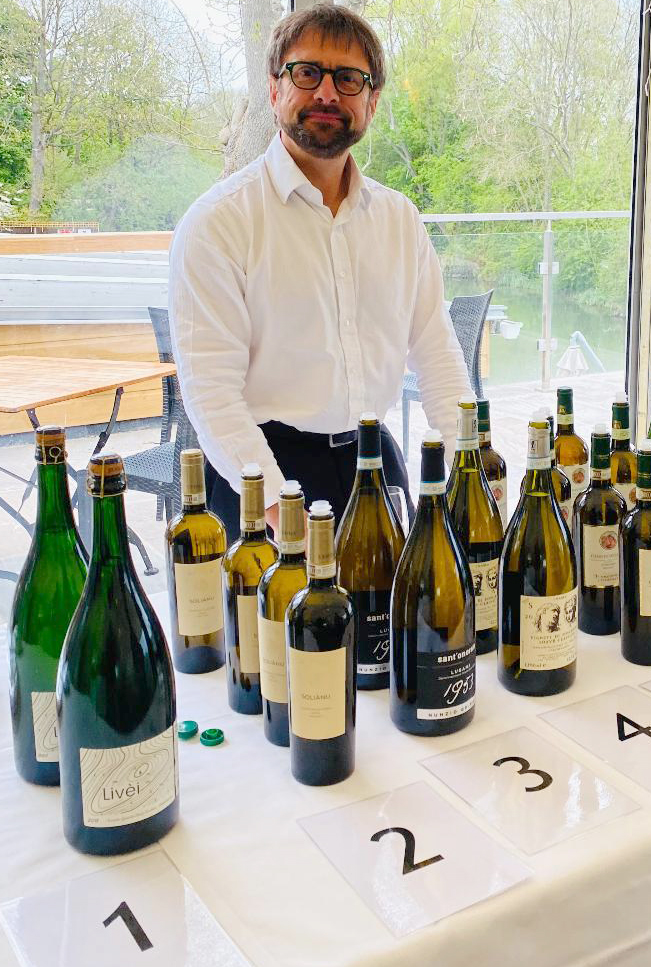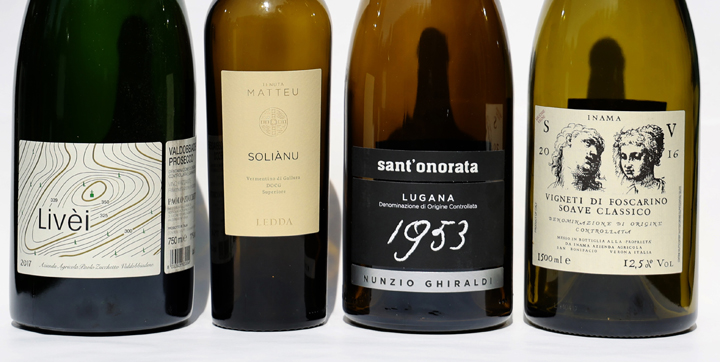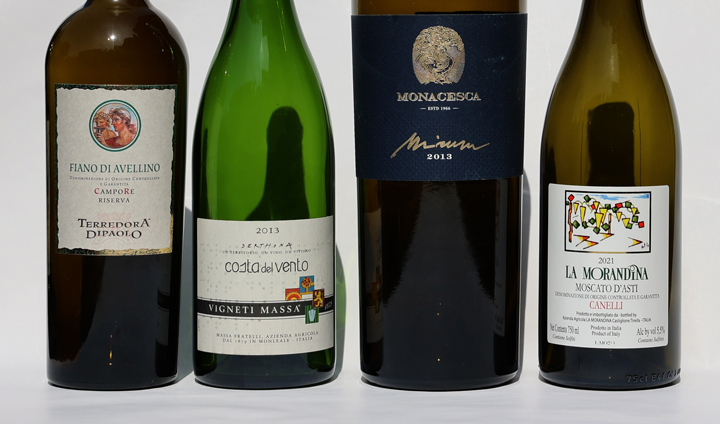 In the world of wine, Italian whites have all too often been seen as the ‘poor cousins’. Thirty years ago it was Lambrusco and raffia-covered flasks of Chianti that dominated the charts. Then came ‘killer Bs’ of northern and central Italy and – for the fully sophisticated the glittering allure of the ‘super-Tuscans.
In the world of wine, Italian whites have all too often been seen as the ‘poor cousins’. Thirty years ago it was Lambrusco and raffia-covered flasks of Chianti that dominated the charts. Then came ‘killer Bs’ of northern and central Italy and – for the fully sophisticated the glittering allure of the ‘super-Tuscans.
Have we moved on? Yes, a bit, thanks in considerable part to our President Michael Palij MW whose Winetraders’ import business has always specialised in the wines of Italy. But can Italy’s white wines provide more than fresh, fruity appeal? Michael came to the Club on a chilly north Oxford evening to upturn some assumptions – and what a freight he brought with him. Generous magnums of serious wines had been dug from Italian producers’ cellars, supplemented by wines from Michael’s own stock.
Fine wine prices have shot up in the last decade as more money competes for limited stock and the explosion of off-trade sales during the pandemic has not helped. £12000 for a box of Premier Cru burgundy is now the going rate. So we should be looking elsewhere…
First up was a Prosecco, though hardly an ‘ordinary’ wine of the type that shifts a staggering 500 mn bottles a year in the UK – around a bottle a month for every one of drinking age in the country. The pair of magnums of Paolo Zucchetto’s wine came from the heart of the most prestigious area of the Valdobbiadene DOC. 100% Glera rather than the lesser grapes from all over Italy that find their way into much prosecco and fully dry rather than dosed to the normal 10 -15g/l for British (and Italian) tastes. In its 19th century origins, Prosecco was a rare treat reserved for weddings, baptisms and the like, generously dosed to complement the sweet Pasticceria that accompanied the celebrations.
the UK – around a bottle a month for every one of drinking age in the country. The pair of magnums of Paolo Zucchetto’s wine came from the heart of the most prestigious area of the Valdobbiadene DOC. 100% Glera rather than the lesser grapes from all over Italy that find their way into much prosecco and fully dry rather than dosed to the normal 10 -15g/l for British (and Italian) tastes. In its 19th century origins, Prosecco was a rare treat reserved for weddings, baptisms and the like, generously dosed to complement the sweet Pasticceria that accompanied the celebrations.
Zucchetto’s wine – by contrast – is bottle-fermented with lots of lees contact rather than tank-fermented and zero dosage. A subtle nose of pears and melon with a hint of autolyis.
A great start – and even better was to follow.
Wine no 2 was the 2019 Solianu from the Vermentino di Gallura Superiore DOCG. Although Sardinia is a fabulous spot for great value wine and superb food, this is Sardinia’s only DOCG area. Andrea Ledda’s vineyard is carved out of a granite quarry in the windswept hills overlooking the Costa Smeralda coast (of Aga Khan and PortoCervo fame). Excavations alone at the vineyard reportedly cost €1 mn but it now produces one of Italy’s greatest wines. Vermentino is Sardinia’s most reputed and most valued white grape and this example had a mesmerising nose of peach, honeysuckle and tangerine overlaid with salinity and a hint of struck match. In the mouth its oily texture, its combination of rich fruit, subtle herbs and distinct minerality matched to extraordinary length and persistence make it a winner with grilled fish, pasta and chicken, perhaps even pork. Stainless steel only and Michael, who has tasted back trough the vintages, assured us that this fundamental strength of character remains unchanged with time – purely adding complexity and increasing layers of flavour. Certainly a wine that would keep for a decade – but could be enjoyed in the here and now.
Go there! ordered Michael, and if CostaSmeralda prices don’t appeal then head a touch south to the port town of Olbia. History, great beaches and stunning food – and further to the south you can find the best tuna in the world at Sant’Antioco along with Carinena from pre-phylloxera vines.
Wine no 3 was Nunzio Ghiraldi’s Lugana DOC Sant’Onorata 1953’ of 2018. The ‘1953’ in the name is down to Nunzio’s grandfather who planted this single vineyard site in the terminal moraine below Lake Garda in that year. This is heavy, clay soil which has only ever had Turbiana vines. The appellation rules now allow other grapes but that’s not for Nunzio. Stainless steel fermentation accentuates the purity of the fruit on a complex nose – lemon peel, grapefruit pith, stone fruit at this early stage of its life. Spicy notes, and a touch of ginger and almond come with age. A wine for roast chicken but with enough power to cope with Italian charcuterie (Culatello di Zibello was mentioned…).
A lower-priced Ghiraldi wine (Family Estate Lugana’) is stocked by Majestic at £14.99 but the extra £4 (after Michael’s generous offer to members is taken into account) makes the ‘1953’ a better bet.
Overall, Michael suggested – though not in such explicit terms – that this might be a time to buy. Raw material costs are rising; shortages of paper, glass and cardboard are hitting producers; energy costs have doubled in Italy in the last five years. Glass – with its high energy costs – is a particular problem but (in response to a question) cans are not definitely a good option. They can be recycled but that means re-melting and another level of energy cost – even if aluminium makes a perfect inert material for wine. One, increasingly popular, solution in the on-trade is pressurised kegs of wine – a bit like a giant Coravin perhaps – which mean that very good wine can be dispensed on demand.
Next up was another of Michael’s long-time suppliers and favourite wines. Stefano Inama’s ‘Vigneti de Foscarino’ from the Soave Classico DOC is known to many Club members but here was a chance to see how it will age. In the days of raffia-Chianti and Lambrusco, Soave was another joke wine. Its name when Michael first met Stefano was ‘mud’. But Stefano’s insistence that Italy might be a land of Fiats but it had Ferraris too, his focus on the potential of the volcanic soil of the Classico area and the quality of his wine persuaded Michael to take a punt with the then Sainsbury buyer. Turning up in Holborn with bottles and tasting glasses, he blagged his way into an interview as part of his ‘Soave Crusade’. The Sainsbury buyer liked the wine and thought 5000 lira a reasonable price – until she realised that was a single bottle not a box of 12. It took some time but, in the end, JS did buy and did stock Stefano’s wine. Result! Now to be found in Waitrose though.
The wine is made from 100% Garganega grapes grown under pergola to shade the grapes which are – rightly – hand-picked. Twelve hours on the skins, natural yeast fermentation and then aged in old oak with just 5% of new Allier barrels in the mix to add a touch of seasoning. Perfect with risotto – but remember to put half the bottle into the risotto whilst reserving half for yourself and friend.
2016 was a hot year and with age the wine had a touch of lifted tropical fruit to complement the camomile, elderflower and iris notes on the nose. In the mouth there’s lots of power, concentrated fruit and a bite of acidity. Intensely good.
In response to a question, Michael explored the issue of what makes a wine ‘age-worthy’. In short, its capacity to develop greater complexity with age. To do that it needs a foundation of acidity and concentrated fruit – the acid holds the wine together, the greater the concentration of fruit the less danger that it will fade away over time. And, apart from some deliberately oxidised wines such as sherry, the ability to exclude all but the barest minimum of oxygen. We know that wines such as German Riesling will almost always reward cellaring. White Burgundy – with the premox scandal hanging over its wines – largely fails to reward long-term cellaring despite the price heights now reached. For a tenth of the price, high-end Italian whites could deliver equal complexity and richness.
 From Stefano’s Soave we moved on to a pair of ‘CampoRe’ Fiano d’Avellino vintages: 2009 and 2016. One of the 2009 bottles proved, on opening, to have lost it; and the quality of the other two was variable – an indication of the potential risks for long-term storage. The 2009 in good condition had a touch of apparent extra sweetness and a more intriguing, spicier nose which had lost a little of the insistent apricot notes and tropical fruit of the 2016.
From Stefano’s Soave we moved on to a pair of ‘CampoRe’ Fiano d’Avellino vintages: 2009 and 2016. One of the 2009 bottles proved, on opening, to have lost it; and the quality of the other two was variable – an indication of the potential risks for long-term storage. The 2009 in good condition had a touch of apparent extra sweetness and a more intriguing, spicier nose which had lost a little of the insistent apricot notes and tropical fruit of the 2016.
Terredora has been a key player in the renaissance of wine in Campania. Formed after a split in the Mastroberardino family left one brother with the vineyards and the other with the winery and the Mastroberardino name, Michael focused on the vineyard and on the Fiano, perhaps the best of the four indigenous grapes of the Neapolitan hills. Despite being far further south than Bordeaux, this wine is harvested a month later than Cabernet Sauvignon, which tells you something about the impact of height (600 m above sea level) but also about the ways vines evolve. Their purpose in life is to spread their seeds. That means attracting birds to eat the grapes and, like humans, that means sweeter grapes appeal. That in turn means that evolution favours those vines which ripen later and thus sweeter.
We then moved to Aldo Cifola’s Verdicchio di Matelica, the 2013 ‘Mirum’ La Monacesca. This was another wine whose reputation sank low in the 1970s and 1980s but has now – at least in part thanks to Michael and his producers – been restored to fame and repute. Matelica is the only valley ini central Italy that runs North-South. Once a lake it now forms a bowl with consequent high day-time temperatures. But at night the cold air flows down off the slopes above and there can be a 20 degree difference in temperature. Great for vines, great for wine. This vineyard – Mirum – was planted in 1966 by Aldo’s father and Michael was their first export customer.
High acid, high(ish) alcohol (14%) and concentrated perfumed fruit make this a great candidate for ageing. Michael put on a tasting for Jancis Robinson that went back to the 1993 and they noted how spicy ginger, white pepper and slightly caramelised apple notes came to the fore while not losing the bite of preserved lemon and the sweetness of ripe fruits. All these characteristics were in evidence in our sample bottles.
Paired with the Verdicchio was Walter Massa’s Timorasso ‘Costa del Vento’ 2014. This was the wine that Michael played a central role in preserving from oblivion in 1989. Walter Massa, barged into a restaurant where Michael was eating with other producers, and insisted that Michael should come a try his wine. No point, said the other producers… but Michael admired his bravado, went and was rewarded with a bottle of 1979 Timorasso from Walter’s 6 ha plot.
The Timorasso grape was almost forgotten at that point. When phylloxera hit in the late nineteenth century, France had the financial and political infrastructure to deal with catastrophe. Italy, still knitting together as a nation after the Risorgimento did not. When the replanted, the producers went all out for the most productive grapes they could. Hence the Gavi district went from Timorasso to the less distinguished but highly prolific Cortese. Massa himself – subsequently recognised as a slightly mad genius - was about to pack up.
But Michael took 25 dozen – without a buyer in sight. His Irish importer of the time went crazy for it and ordered 50 cases. Grape saved! Jancis made it her wine of the month and now there are over 200 ha of Timorasso producing this powerful, highly concentrated wine which has great acidity, great citrus, stone and floral fruit and a creamy, honeyed texture.
The final wine of the evening was La Morandina, a 2021 Moscato d’Asti from Canelli. This, as Michael noted, is not a wine that one normally considers worth ageing. Fresh, delicious, with nuanced red fruit flavours – just perfect for all kinds of summery desserts, yes, but ageing in bottle, no! However, a both of 2013 tasted some years ago was still ‘fresh as a daisy’ but with added notes of sage, bay and basil. So, worth buying a case and putting a few away to sample after five or so years was Michael’s suggestion.
Closing the tasting, Michael noted that topping and tailing such a session with two of Italy’s ‘ordinary’ wines was perhaps counter-intuitive … but the Prosecco, fresh and light, set us up for a evening of fascinating, complex and at times challenging wines – whilst the Morandina made for a delicious end point before we tucked into bread and cheese and raided the remains of the magnums.
GH: 28/4/22